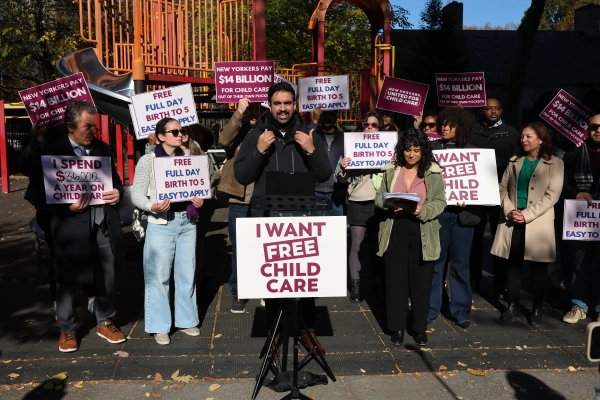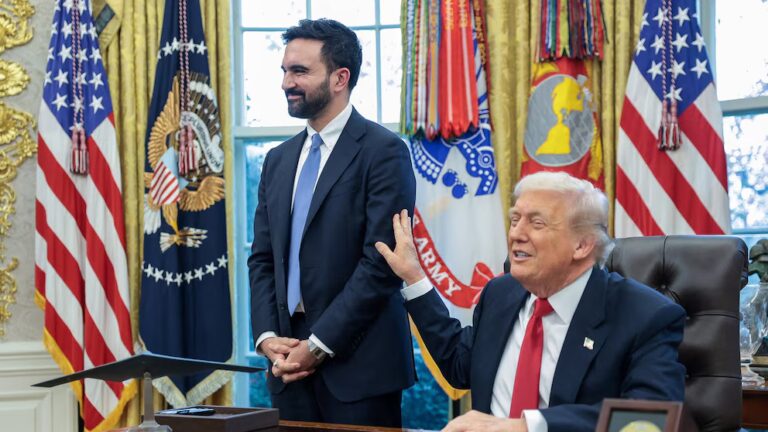“`html 
Zohran Mamdani, the 34 year old progressive candidate who’s greatly ahead in the New York City mayoral contest, has centered his campaign around widespread child care, continually returning to it as a crucial policy with the potential to transform the services offered by City Hall. He’s committing to providing complimentary child care to all New York City residents from the age of 6 weeks up to 5 years, while simultaneously increasing wages for caregivers to align with those of public school educators.
It’s not difficult to understand the necessity for changes within the city’s existing system for childcare. Families, with children aged under 6, are exiting New York City at double the rate compared to others. A substantial majority, exceeding 80 percent, of families with young children cannot manage the financial burden of care that reaches upwards of $20,000 annually. The departure of these younger families is estimated to cost the city approximately $23 billion each year in unrealized economic output. “It’s not solely about parents with young children — child care and offering care also significantly impacts grandparents and numerous older individuals too,” mentioned Louise Yeung, the campaign’s policy head for Mandami.
Nevertheless, this is an atypical risk, especially when most individuals residing in New York don’t have small children. Although most would agree that childcare is significant, the core issue hinges on whether a politician should base their entire campaign upon a matter that might not be as critical to voters as initially perceived.
Mamdani’s campaign builds upon a major change regarding the manner in which Democrats have addressed the topic of childcare over the prior five years. In the wake of the pandemic, prominent figures have started framing it not so much as an individual issue for each family to resolve independently, but increasingly as crucial “human infrastructure” — deemed as vital to both society and the economy as the construction of new roads and bridges.
But, what’s the opinion of the voting public?
When querying Americans for their view on childcare, the figures appear imposing. However, these seemingly elevated numbers might be misinterpreted.
What Americans think about child care
Almost 75% of Americans believe the pricing of childcare is excessively high, according to a July 2025 AP-NORC survey, and a majority across both major political parties favor government intervention to improve its affordability. One survey from 2023, conducted by GQR and the Child Care for Every Family Network, found that 73% of voters regarded the childcare system as “fundamentally flawed,” with 84% seeing it as “economic infrastructure.”
However, when pollsters prompt voters to prioritize issues, childcare sinks down the scale. Forthcoming survey data from Searchlight Institute, an emerging liberal think tank, discovered that a mere 6% of registered voters in seven swing states regarded childcare as their most pressing concern, with only 22% placing it among their leading three. Even when focusing on younger demographics, its ranking is only mid-tier — significantly lower than issues such as health services, housing, and inflationary trends, as evidenced by information from Blue Rose Research, another Democratic polling entity.
“It’s easy to say you approve of a lot of stuff when you aren’t being required to choose between options,” said Charlotte Swasey, the director of analytics at Searchlight. “Generally, asking approval is a great way to get positive numbers towards anything respondents are vaguely okay with.”
That tension — between broad support and weak urgency — has long defined the politics of child care. As child care analyst Elliot Haspel has written, voter support for the issue is “butter soft” — strong enough to make politicians feel safe talking about it, but rarely strong enough to make them act. The pandemic made child care more salient — the glaring absence of it became everyone’s problem — but the urgency faded as offices reopened with blunt return-to-work mandates that assumed child care access had simply sorted itself out.
Blue Rose does find that even though child care is a lower priority for voters, Democrats have a “trust” advantage on it compared to Republicans. “Democrats benefit when they keep their focus on the issues that are most important to voters — the economy and health care,” Blue Rose’s director of research Ali Mortell told me. “Issues like child care, abortion, or climate change can color your language or add to a broader narrative, but it would be a strategic misstep to fixate a campaign narrative solely on any one of those.”
Beyond the polls
So what do we make of this? One lesson is that polling can guide a candidate, but only so much. In some ways Mamdani is doing exactly what campaign strategists would advise: packaging the issue inside a broader affordability crisis. When he talks about child care — and he talks about it often — it’s almost always in the same breath as rent freezes, free buses, and city-run grocery stores. On the other hand, he’s following his gut and not shying away from making child care truly central to his bid, even though there are other cost-of-living issues that affect more New Yorkers at any given moment.
Related
- The buzzy word that Democrats have pinned their hopes on
- Zohran Mamdani’s not-so-radical agenda
Achieving a higher voter ranking for child care matters will likely involve combining different community strategies. For some individuals, this may require relating care shortages to concerns regarding population decline. For other individuals, this could involve investing further into memorable personas from Hollywood, which could aid in altering widespread narratives. As recently detailed by the 19th News, some care advocates now urge writers and producers to handle child care in a similar fashion as previous approaches to drunk driving or LGBTQ+ representation — viewing it as something that can alter how the public perceives things through storytelling. Some claim that leading figures may need to discover methods to re-contextualize the purpose of childcare itself. As Kathryn Jezer-Morton stated in The Cut, “For child care at reasonable prices to become an engaging topic to people that live within individualistic societies, it has to revolve around topics apart from just children.”
In some ways, this is the same tension that sank the expanded Child Tax Credit. In 2021, the American Rescue Plan temporarily increased the credit and made monthly payments available to nearly all families with children, cutting child poverty in half almost overnight. But the policy never garnered the moral legitimacy of programs like Social Security or Medicare. It wasn’t “earned” through work requirements, and it wasn’t narrowly targeted — it sat uneasily between families viewed as “deserving” and “undeserving.” Once the emergency moment passed and the payments expired at the end of 2021, so did the political will to revive them.
Universal child care could fall into that same trap. It’s popular in theory, but voters don’t always resonate with the challenge, especially if they’re past the stage of needing it or never had kids at all. Mamdani’s bet is that by talking about child care as part of the city’s affordability crisis — not as a moral appeal or a benefit for parents — he can pull it out of that gray zone.
Whether that works depends on whether voters come to see the cost of raising kids as something that shapes the city’s future, not just individual family budgets. If Mamdani wins, it probably won’t be because New Yorkers felt sudden new sympathy for struggling parents. It will be because they saw their own survival in the same frame.
This work was supported by a grant from the Bainum Family Foundation. Vox Media had full discretion over the content of this reporting.
“`
Source: vox.com






